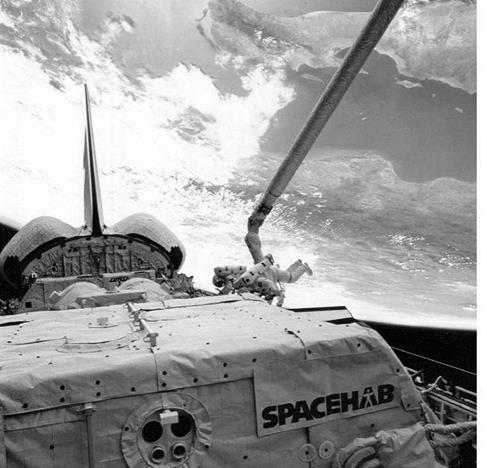STS-57
|
Int. Designation |
1993-057A |
|
Launched |
21 June 1993 |
|
Launch Site |
Pad 39B, Kennedy Space Center, Florida |
|
Landed |
2 July 1993 |
|
Landing Site |
Runway 33, Shuttle Landing Facility, Kennedy Space Center, Florida |
|
Launch Vehicle |
OV-105 Endavour/ET-58/SRB BI-059/SSME #1 2019; #2 2034; #3 2017 |
|
Duration |
9 days 23 hrs 44min 54 sec |
|
Call sign |
Endeavour |
|
Objective |
Retrieval of the ESA EURECA reusable platform; inaugural flight of the SpaceHab laboratory module; 2nd EVA operations and training exercise |
Flight Crew
GRABE, Ronald John, 47, USAF, commander, 4th mission Previous missions: STS 51-J (1985); STS-30 (1989); STS-42 (1992)
DUFFY, Brian, 39, USAF, pilot, 2nd mission Previous mission: STS-45 (1992)
LOW, George David, 37, mission specialist 1, payload commander, 3rd mission Previous missions: STS-32 (1990); STS-43 (1991)
SHERLOCK, Nancy Jane, 34, US Army, mission specialist 2 WISOFF, Peter Jeffrey Karl, 34, civilian, mission specialist 3 VOSS, Janice Elaine, 36, civilian, mission specialist 4
Flight Log
The original mid-May launch of STS-57 was rescheduled to June to allow both launch and landing to occur in daylight. The 3 June launch date slipped when a decision was made to replace the high-pressure oxidiser turbo-pump on SSME # 2 after concerns over a misplaced inspection stamp on a spring in the pump. This also allowed time to investigate an unexplained loud noise heard after Endeavour arrived at the pad, which was eventually traced to a ball strut tie rod assembly inside the 43 cm LH line. The 20 June attempt was scrubbed at T — 5 minutes due to low clouds and rain at the SLF, as well as weather concerns at all three TAL landing sites.
SpaceHab was a commercially developed pressurised laboratory designed to double the workspace available for crew-tended experiments. Originally developed to meet the need for commercial scientific payloads that could be accommodated in the mid-deck, such experiments and payloads did not require the use of the Spacelab pressurised modules and could be flown on non-Spacelab missions. However, the
|
High over Baja California, astronauts Low (nearest camera) and Wisoff attach a mobile foot restraint to the end of the RMS. Also in frame are the new SpaceHab augmentation laboratory module (foreground) and the captured EURECA (at rear of payload bay) |
mid-deck locker space available on a Shuttle flight was limited and additional room was required, hence the development of SpaceHab. Though the commercial aspect of Shuttle operations did not materialise as originally foreseen, SpaceHab nevertheless evolved into an effective logistics carrier for later Shuttle-Mir and ISS operations. The inaugural flight contained 22 experiments (half supplied by NASA) that covered materials and life sciences, as well as a waste water recycling experiment that was planned for use on the space station. In addition, there was a hitchhiker experiment in the payload bay designed to collect data on X-ray radiation from diffuse sources in deep space. As with most Shuttle missions, several secondary experiments were carried in the mid-deck in addition to those located in the SpaceHab module. These additional
experiments supported the materials and life sciences experiments flown in the module.
During FD 4, the crew retrieved the ESA EURECA carrier using the RMS. During attempts to stow the EURECA in the payload bay, ground controllers were unable to command the two antennas to fold, so the astronauts spent the start of their EVA period on 25 June manually folding both antennas to enable the carrier to be returned to Earth. This vehicle had been deployed from STS-46 in 1992 on the first of five planned flights of the carrier, each lasting six months over a ten-year period. A second flight opportunity in 1995 was passed up by ESA due to lack of funds and the 1997 launch opportunity was also not taken up. The EURECA reusable carrier remained unused after its first mission.
In the second of the series of generic EVAs planned for 1993, Low (EV1) and Wisoff (EV2) spent 5 hours 50 minutes outside Endeavour on FD 5. In addition to manually folding the EURECA antennas, the two astronauts became the first crew to use the Shuttle airlock as part of the payload bay tunnel extension. All previous Shuttle-based EVAs had been directly out of the airlock in the mid-deck. The astronauts evaluated moving a large mass (another astronaut) while attached to the foot restraints on the RMS, or located on the side of the payload bay. They also evaluated the movement of safety tethers while on the RMS and worked with different tools to gauge the stability of the restraints while tightening or loosening a bolt. These tests were important evaluations for both the space station and for the forthcoming Hubble Telescope service planned for mission STS-61 later in the year. While working in the night side of the orbit, the EVA crew experienced low temperatures which caused shivers, numbness and painful hands.
Landing attempts on 29 and 30 June were waived off due to unacceptable cloud cover and rain at KSC, the first time since STS 61-C in January 1986 that a mission had received two waive-offs. Following their eventual landing on 2 July, the crew talked with the STS-51 crew, who were conducting a training exercise in Discovery on Pad 39B. This was the first orbiter-to-orbiter conversation since the orbiting STS 51-D crew talked with the STS 51-B crew at KSC in 1985. Following STS-57, Endeavour was scheduled for an extended inspection period.
Milestones
161st manned space flight
86th US manned space flight
56th Shuttle mission
4th flight of Endeavour
27th US and 50th flight with EVA operations
1st flight of SpaceHab augmentation module











